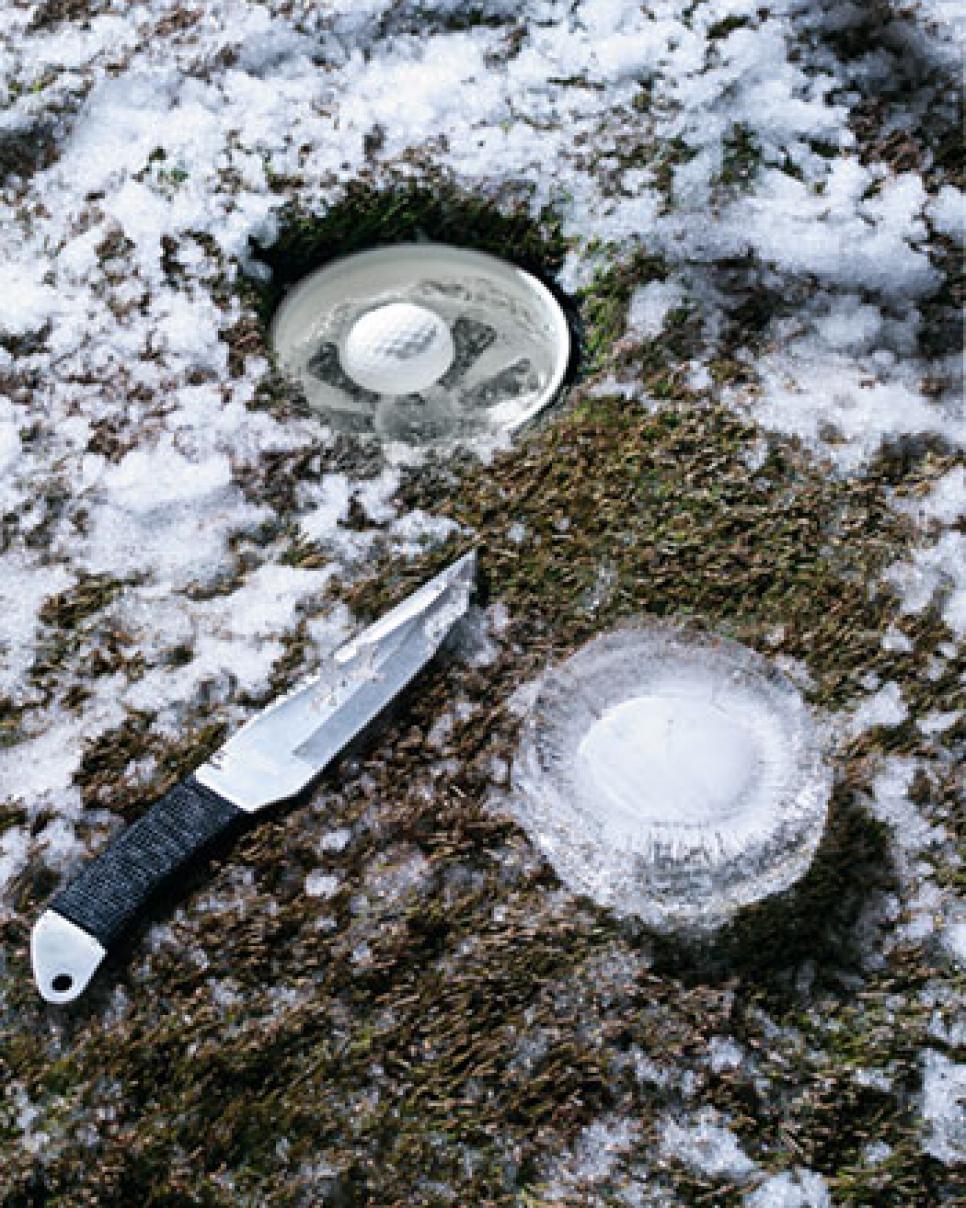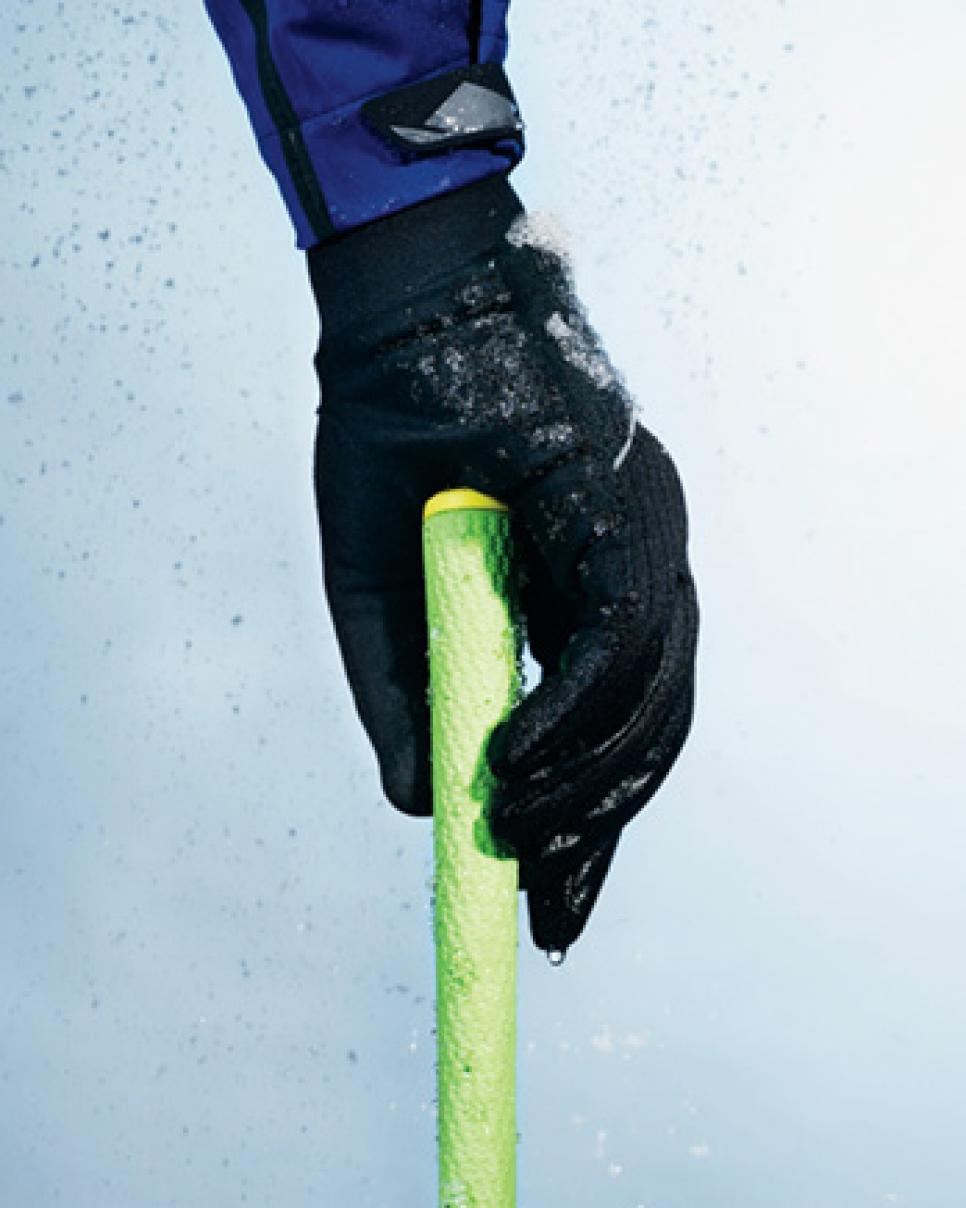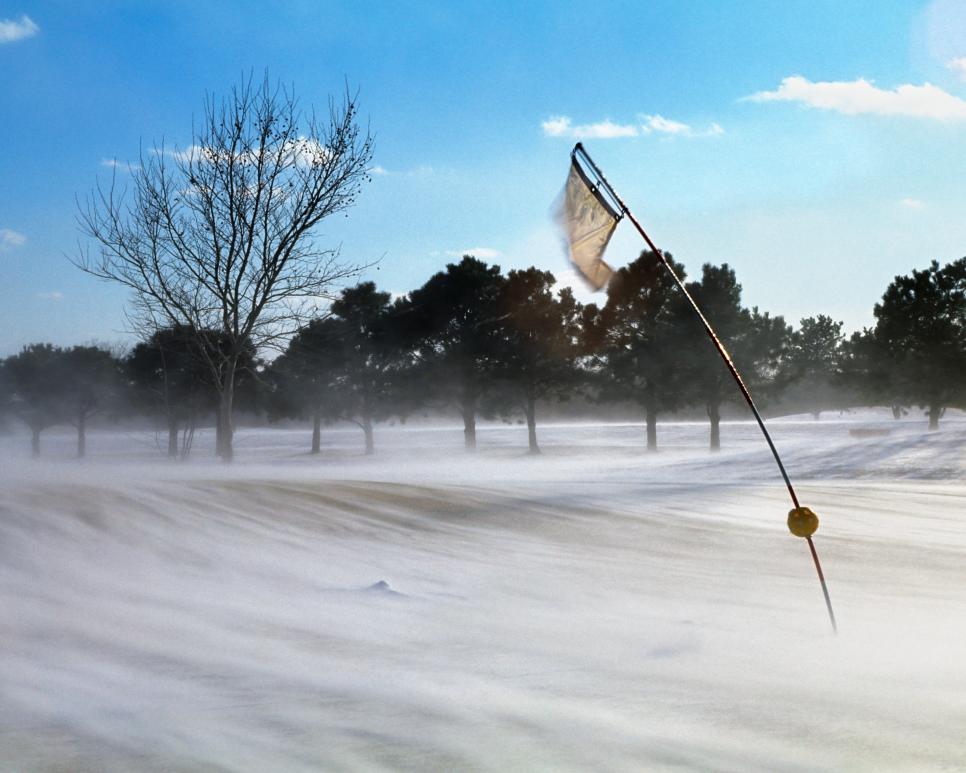A lone golfer carries his bag in a freezing rain, and the driver of a passing car—wipers, radio and heater cranking—sees him clearly through the winter-bare trees bordering the course and says, "There's a guy who must hate his family."
In fact, the golfer has a wife and daughter he loves very much. But same as he has learned to dive into cold water rather than dip a toe, he's found that s#!t-weather golf really isn't that bad once you get past the initial shock. And it's at least better than the alternative of no golf.
The population of true "all-weather" golfers is very small. Simply remaining cheerful when snapping on raingear in a tournament doesn't count. All-weather golfers play when the clear choice is not to play. They play when it's almost guaranteed the course will be empty. They say things like, "There is no such thing as bad weather, only bad golfers." In extreme cold, wind and rain—hopefully not a combination of all three—they get out there.
It's arguably a different sport. But if you like golf, there are a lot of similarities. Paramount is to never lose one's sense of humor. There are other critical safety and performance factors to consider, which we've assembled here. Read on... if you're tough. —Max Adler

YOUR COURSE
Is it playable? The person with the firm answer is your course superintendent. If there's frost on the ground, then no. "Grass is 90 percent water. When the cells freeze, they become brittle, and a single footstep will shatter the plant's structure," says Keith Ihms, president of the Golf Course Superintendents Association of America. "Two or three days after a golfer walks on frozen grass, it dies. There's nothing you can do once the wound's been inflicted." You'd think this means 32 Fahrenheit is the magic number for course safety, but vagaries in dewpoint and ground temperature make it trickier.
"It isn't completely understood when frost will do damage," says Chris Hartwiger, director of the USGA Course Consulting Service. "There is sometimes a 15-to-20-minute window when the frost is there and the plant isn't as rigid as it once was, and it'd be safe to walk on." This window typically coincides with a group of golfers, belligerent from having drunk more coffee than intended, banging on the starter's window. The practice green and first tee look fine, but these guys can't see the second green, which is shaded by pines and gathers humidity from the river and is as frosted as Ian Poulter's hair tips. "The right thing is to always be conservative and just wait until the frost is off all the greens," Hartwiger says.
So why do some courses, particularly those in the Northeast, allow play all winter? Answer: Because the grass isn't growing. "If the grass is dormant and the turf is basically frozen, golfers can have at it," Ihms says. "It's only when the ground is going in and out of thawing that you can do real damage." —Max Adler
YOUR GEAR
The only piece of equipment you need to worry about is your ball. According to Fujikura, you'd have to be playing in Antarctica to even consider the temperature affecting graphite-shaft performance. And though Golf Pride has several tour players who switch from cord grips to softer rubber when the temps dip below 60 degrees, this is more a matter of coddling cold fingers than the material changing.
Callaway engineers tested aerodynamics with a robot and found that drives carried seven yards shorter at 50 degrees versus 90 degrees. (When you combine aerodynamics and a ball's resilience as the temperature falls, expect four yards of carry loss for every 10-degree drop.) "The molecules become more tightly packed in cold temperatures, which results in a harder compression," says Dave Bartels, Callaway's senior director of golf-ball research and development.
Balls stored in a car trunk in an extreme winter climate will perform fine, Bartels says, if you warm them up before play. Unfortunately, pressing a ball against pocket warmers between holes violates Rule 14-3. Your best option is to play a lower-compression ball. "Lower-compression golf balls perform better in cold weather because as their compression increases, they're still relatively soft and able to be compressed on the clubface," he says. "Compressing the ball helps reduce spin with your longer clubs for increased distance." It also just feels better, which is important—hitting one thin in the cold feels about as good as slamming your fingers in that car trunk. —Keely Levins
YOUR SWING
The good news is, people in the know are concerned you'll play too well. Forward tees, slow greens, puny rough and less foliage mean a course can play significantly easier than its rating. This is why the USGA supports certain state golf associations observing an inactive season, when scores can't be posted for handicap purposes. Conversely, of course, is the concern that with numb hands you'll shoot a thousand.
Even on an "easier" course, special knowledge is needed to navigate extreme conditions. Golf Digest Best Young Teacher Jason Guss works year-round at his two academies in Michigan and played one high school state championship in the snow and another in severe cold. "It's about managing the lies you're going to see—either on frozen, hard turf or something wet and muddy," Guss says. "On both kinds of shots, move the ball back in your stance a bit and set your weight slightly toward the target, both of which will help you hit the ball first. A three-quarter backswing is good, too, because of your jacket and because it will help keep you stable when the footing might not be that great."
On hard ground, Guss says a low cut will be your most productive shot. "An outside-in swing will give you the attack angle you need when there's no room under the ball, and the low-shot feel will keep you from scooping your hands," he says. "If you try to lift it off a hard lie, you'll bounce the club into the ball—and that will hurt in more ways than one."
From wet lies, a shallower, inside-to-out path will keep the clubhead from digging. "Aim a little left of your target and feel the face stay open through impact. That will keep the bounce exposed and produce more height." This "Nicklaus push-cut" certainly isn't for beginners, Guss says, but it can be worth striving for. —Matthew Rudy
YOUR BODY
Accept you won't have the same strength, coordination or feel as you would on a summer day. "Believe it or not, things start to get more difficult when the temperature dips below 59 degrees Fahrenheit," says Dr. John Castellani, a physiologist at the United States Army Research Institute of Environmental Medicine. "That's when you start to lose tactile sensation and dexterity in the hands."
The best thing you can do is to keep moving, so don't let your lazy buddy talk you into riding a cart. In severe cold weather, your body's internal temperature drops the longer it's exposed, and technically, you're suffering from hypothermia once it decreases from a normal mark of 98.6 to 95 degrees. On the extreme side, hypothermia can cause cardiac or respiratory failure. But long before that happens, your brain restricts blood flow at the body's periphery, like in the hands and feet, because there it's not needed as much to survive. This is why cold golfers will grip the club extremely tightly—virtually guaranteeing a bad shot—without being aware they're doing so.
Shivering, another involuntary protective measure to generate body heat, also can interfere with your game. "When you shiver, your muscles are contracting to generate heat," Castellani says. "You can override shivering to some extent, but performing the fine motor skills needed to swing the club or steady yourself over a four-footer, it's not easy."
Research shows cold water robs the body of heat as much as 25 times faster than cold air. That's why a rainy 45-degree day can be more deleterious to a golf swing than a dry 32-degree day. "As the muscles, tendons and joint fluids get colder, there is reduced function," Castellani says. "They simply don't react as quickly or strongly."

In short, the cold's effect on you, not your golf ball, is the primary reason for your popcorn drives. —Ron Kaspriske
YOUR HEAD
Turns out the people who call you crazy for teeing it up in bad weather have a point. "It varies by person, but under 50 degrees you see diminishing of mental functions such as exercising self-control, using memory, suppressing emotions and making decisions, which are all related to golf," says sport psychologist Dr. Gio Valiante, whose clients include Camilo Villegas and Will MacKenzie. The effects are most pronounced after several hours of exposure, or somewhere in the middle of your back nine. Knowing your faculties will likely erode, Valiante suggests a conservative game plan. "Nasty weather can be a distraction, so the tendency is to lose patience and take more risks. You need to accept that your brain and body are not what they are on a normal day, and aim and club accordingly."
Will you know if you're starting to lose it? "If you're having trouble focusing on the shot you're about to hit, that's an indication of the onset of cognitive deficiency," Valiante says. "How you react to a shot is the other indicator." As in, if you're getting mad and frustrated, it might be because you're really cold. "Better players typically find a way to underreact to every shot, good or bad."
Underreact? That's how a true s#!t-weather golfer handles the forecast.—Max Adler
THE LINE OF SANITY
"You should be able to hold your head up. If you can't look up without rain just punching you in the eye, that's when we call it."—Marc Chandonnet, Seattle University men's golf coach
"I've practiced in snow and sub-zero temps. I'd just run back into the clubhouse every 30 minutes or so to get warm." —Maria Balikoeva, Ladies European Tour member, 2004 and 2006 Russian Ladies Amateur Champion
"Walking is best, but if you can't walk, use a covered cart with a propane heater. If possible, ride alone and keep your clubs in the cart with you."—George Collum, Golf Digest's No. 1-ranked teacher in Alaska
COLD MYTHS
1. BOOZE KEEPS YOU WARM. Alcohol increases your chance of hypothermia because it's a vasodilator. It causes blood vessels to dilate so blood flow to your extremities will remain strong. You'll feel warmer, but your core temperature will drop because your body's natural (sober) defense is to maximize blood flow to your vital organs. A thermos of hot tea, however, is a smart idea.
2. COLD AIR IS HARDER TO BREATHE. No matter how cold it is outside, once air reaches your lungs, it's body temperature. Any irritation you feel is almost always a result of air being dry.
3. GOLFERS FROM COLD REGIONS HAVE A PHYSIOLOGICAL ADVANTAGE. Whether you grew up in Siberia or the Bahamas, the body reacts the same way to cold weather. The former might develop a better psychological tolerance to icy days, but the body will shiver just as much.
HOW TO DRESS FOR 35° AND SUNNY
First Layer: Snug short-sleeve or sleeveless shirt made of tech fabric, like Capilene. Wicks moisture from your trunk without adding bulk to your arms.
Second Layer: Turtleneck. The real deal, not a mock.
Third Layer: Quarter-zip or half-zip pullover or a medium-weight down vest. Stay away from lots of pockets and zippers. You're not going fly-fishing.
Fourth Layer: Windproof jacket. Hopefully it can spend some time in your bag.
Bottom: Long underwear with windproof pants. No regular underwear. You don't need any extra commotion down there.
Paws: Mittens between shots is a must. Double up your socks, but if you can't wiggle your toes, cut foot beds from two sheets of newspaper instead. There's usually a spare paper in the locker room, and dead trees are surprisingly insulating.
Noggin: A wool or fleece winter hat. Triple wagers against anyone wearing a baseball cap. —Marty Hackel
